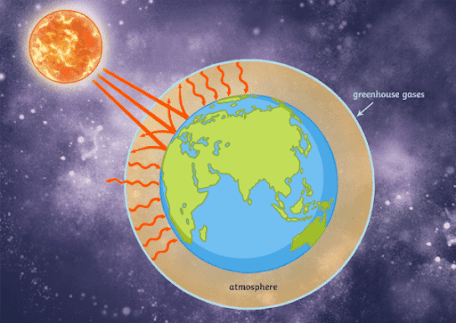
Global warming Greenhouse gases are gases that contribute to the greenhouse effect, leading to global warming and climate change by trapping heat in the Earth’s atmosphere. These gases are essential for maintaining a stable temperature on our planet, but an excess of them from human activities has led to an enhanced greenhouse effect. Some of the key greenhouse gases include:
Global Warming Green House Gases In The Atmosphere
Carbon Dioxide (CO2): Carbon dioxide is the most abundant and well-known greenhouse gas. It is primarily released into the atmosphere through the burning of fossil fuels, deforestation, and various industrial processes.
Methane (CH4): Methane is a potent greenhouse gas, released during the production and transportation of coal, oil, and natural gas, as well as from agricultural activities, livestock digestion, and the decay of organic waste in landfills.
Nitrous Oxide (N2O): Nitrous oxide is another potent greenhouse gas, emitted from agricultural practices (especially the use of synthetic fertilizers), industrial activities, and the burning of fossil fuels.
Main Causes Of Green Houses Gases
Water Vapor (H2O): Water vapor is the most abundant greenhouse gas, but its concentration is primarily controlled by natural processes. Human activities can indirectly affect water vapor levels by influencing other greenhouse gas concentrations.
Chlorofluorocarbons (CFCs): CFCs were used in the past as refrigerants, propellants, and solvents, but they have a high global warming potential. Their production has been phased out due to their harmful effects on the ozone layer.
Hydrofluorocarbons (HFCs): HFCs have been used as replacements for CFCs in various applications, such as air conditioning and refrigeration. They are potent greenhouse gases and are the focus of efforts to reduce emissions.
Perfluorocarbons (PFCs): PFCs are used in the manufacturing of certain products and in the electronics industry. They have high global warming potentials and are targeted for reduction under international agreements.
Sulfur Hexafluoride (SF6): SF6 is used in various industrial applications, including electrical equipment. It has an extremely high global warming potential and is regulated to reduce emissions.
Controlling and reducing the emissions of these greenhouse gases is crucial in mitigating the impacts of global warming and limiting the increase in global temperatures. International agreements, such as the Paris Agreement, aim to address and reduce these emissions to combat climate change and the associated environmental and economic consequences.








